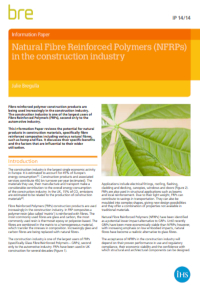Natural fibre reinforced polymers (NFRPs) in the construction industry IP 14 14
Natural fibre reinforced polymers (NFRPs) in the construction industry (IP 14/14) was written by Julie Bregulla and published by BRE on 10 November 2014. BRE (Building Research Establishment) is an independent, research-based consultancy, testing and training organisation, operating in the built environment and associated industries.
In FRP composites a polymer resin (a matrix) is reinforced with fibres. The most commonly-used fibres are glass and carbon, the most commonly-used resin is thermoset epoxy or polyester-based. The fibres are combined in the matrix to a homogeneous material, which transfers the stresses in the composition.
The construction industry is one of the largest users of fibre reinforced polymers (FRPs), (specifically Glass Fibre Reinforced Polymers – GRPs), second only to the automotive industry.
Applications include electrical fittings, roofing, flashing, cladding and decking, canopies, windows and doors. FRPs are also used in structural applications such as beams and local reinforcement. Due to their light weight, FRPs can contribute to savings in transportation. They can also be moulded into complex shapes, giving new design possibilities, and they offer a combination of properties not available in traditional materials.
However, increasingly Glass Fibre Reinforced Polymers are being replaced with Natural Fibre Reinforced Polymers (NFRPs), a potential lower impact alternative. Until recently GRPs have been more economically viable than NFRPs; however, with an increasing emphasis on low embodied impacts, natural fibres have become a realistic alternative.
This 8-page information paper reviews the potential for fibre reinforced composites in construction materials, including natural fibres, such as hemp and flax. It discusses their specific benefits and the factors that affect their utilisation.
Its contents are:
- Introduction.
- Materials.
- Material selection.
- Fabrication.
- Performance.
- Applications.
- Conclusions.
- References.
- Further reading.
[edit] Related articles on Designing Buildings Wiki
Featured articles and news
Editor's broadbrush view on forms of electrical heating in context.
The pace of heating change; BSRIA market intelligence
Electric Dreams, Boiler Realities.
New President of ECA announced
Ruth Devine MBE becomes the 112th President of the Electrical Contractors Association.
New CIAT Professional Standards Competency Framework
Supercedes the 2019 Professional Standards Framework from 1 May 2025.
Difficult Sites: Architecture Against the Odds
Free exhibition at the RIBA Architecture Gallery until 31 May.
PPN 021: Payment Spot Checks in Public Sub-Contracts
Published following consultation and influence from ECA.
Designing Buildings reaches 20,000 articles
We take a look back at some of the stranger contributions.
Lessons learned from other industries.
The Buildings of the Malting Industry. Book review.
Conserving places with climate resilience in mind.
Combating burnout.
The 5 elements of seiri, seiton, seiso, seiketsu and shitsuke.
Shading for housing, a design guide
A look back at embedding a new culture of shading.
The Architectural Technology Awards
The AT Awards 2025 are open for entries!
ECA Blueprint for Electrification
The 'mosaic of interconnected challenges' and how to deliver the UK’s Transition to Clean Power.
Grenfell Tower Principal Contractor Award notice
Tower repair and maintenance contractor announced as demolition contractor.
























